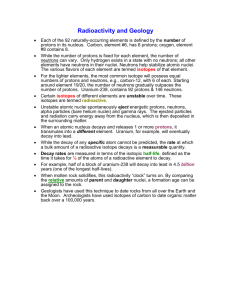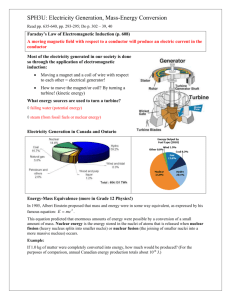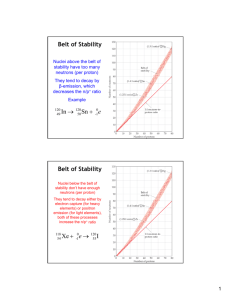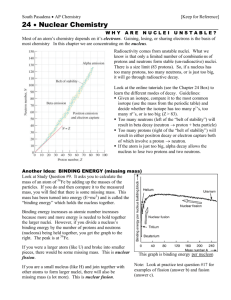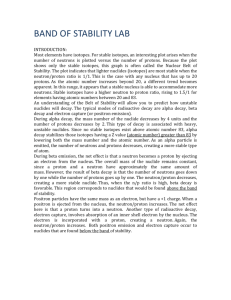Nuclear Chemistry
advertisement
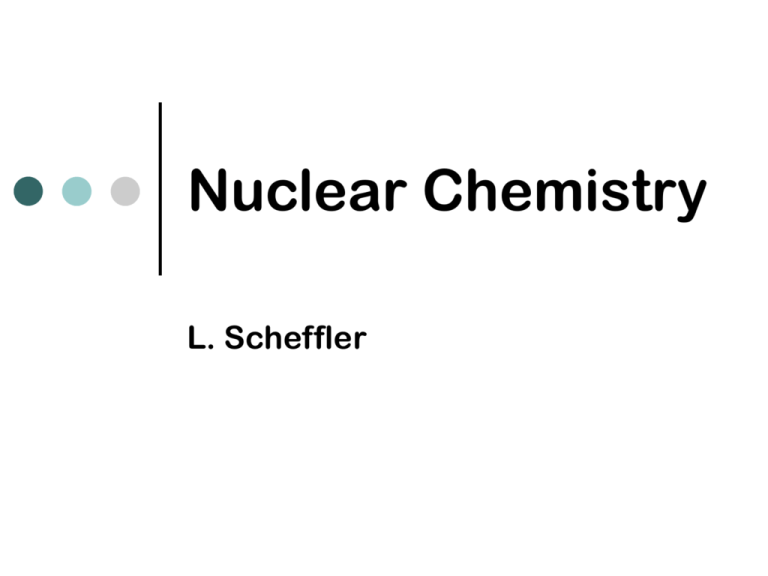
Nuclear Chemistry L. Scheffler The Nucleus The nucleus is comprised of the two nucleons: protons and neutrons. The number of protons is the atomic number. The number of protons and neutrons together is effectively the mass of the atom. Isotopes Not all atoms of the same element have the same mass due to different numbers of neutrons in those atoms. There are three naturally occurring isotopes of uranium: Uranium-234 Uranium-235 Uranium-238 Radioactive Nuclei The nuclides of some of the isotopes of certain isotopes unstable, or radioactive. They are known as radionuclides. Radionuclides can decay into a different nuclide by several different methods. Spontaneous Radioactivity Spontaneous radioactivity involves unstable nuclei which decay with the eventual formation of a stable nuclei. Thus some nuclei are stable and others are not, for example 12C and 14C , 3H and 40K. The isotopes in these examples have the same number of protons but differ in the number of neutrons. Stability Factors 1. 2. Two important factors determine nuclear stability The mass number (which is the total number of nucleons in the nucleus) the neutron to proton ratio. Stability Factors 180 In the nucleus, positively charged protons repel each other. As the number of protons in the nucleus increases, the forces of repulsion between the protons increases substantially. More neutrons are required to maintain stability 140 120 # neutrons 160 100 80 60 40 20 0 0 50 100 # protons 150 Alpha Emitters If a radionuclide has a lower neutron to proton ratio than for a stable nucleus, it falls to the right of the stable nucleus To increase the neutron to proton ratio back to a stable ratio, it undergoes alpha decay. Releasing an alpha particle raises the neutron to proton ratio since the number of neutrons is greater than or equal to the number of protons Beta Emitters If a radionuclide has a higher neutron to proton ratio than for a stable nucleus, it falls to the left of the stable nucleus To reduce the number of neutrons back to the stable ratio it undergoes beta decay. A neutron disintegrates with the emission of a high speed electron known as a beta particle: A proton is produced from the neutron. This raises the number of protons by one and reduces the number of neutrons by one. The neutron to proton ratio is lowered until it reaches a stable value. Then no further radioactive occurs Other Forms of Nuclear Decay If a radionuclide has a lower neutron to proton ratio, a proton can also be transformed into a neutron by either positron emission or electron capture. Heavy Nuclei Are Always Unstable If the total number of nucleons exceeds 209, the limit for stable nuclei, the nucleus always lies beyond the stable limit The nucleus is always radioactive. Several types of radioactive decay are involved in order to reach the stability. For example, the radioisotope 238U undergoes a sequence of fourteen radioactive decay steps before forming the final product 206Pb. Nuclear Binding Energy When a nuclear reaction occurs the mass of the particles is not conserved. The early quantum physicists were able to demonstrate that there is a small change in mass when a particle is moving. It is given by the formula . . . . . . . . Fission is the release of energy by splitting heavy nuclei such as Uranium-235 and Plutonium-239 How does a nuclear plant work? • Each fission releases 2 or 3 neutrons • These neutrons are slowed down with a moderator to initiate more fission events • Control rods absorb neutrons to keep the chain reaction in check Controlled Fission Chain Reaction D-T Fusion D T Fusion is the release of energy by combining two light nuclei such as deuterium and tritium 4He 3.52 MeV Neutron 14.1 MeV • The goal of fusion research is to confine fusion ions at high enough temperatures and pressures, and for a long enough time to fuse • This graph shows the exponential rate of progress over the decades Confinement Progress There are two main confinement approaches: The energy from the reaction drives a steam cycle to produce electricity Nuclear Power Plant Nuclear Power produces no greenhouse gas emissions; each year U.S. nuclear plants prevent atmospheric emissions totaling: •5.1 million tons of sulfur dioxide •2.4 million tons of nitrogen oxide •164 million tons of carbon Nuclear power in 1999 was the cheapest source of electricity costing 1.83 c/kWh compared to 2.04 c/kWh from coal • Magnetic Confinement uses strong magnetic fields to confine the plasma • This is a cross-section of the proposed International Thermonuclear Experimental Reactor (ITER) • Inertial Confinement uses powerful lasers or ion beams to compress a pellet of fusion fuel to the right temperatures and pressures • This is a schematic of the National Ignition Facility (NIF) being built at Lawrence Livermore National Lab


